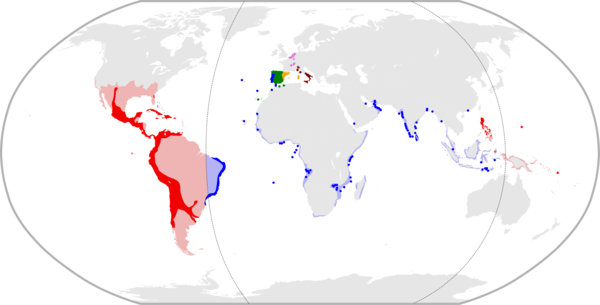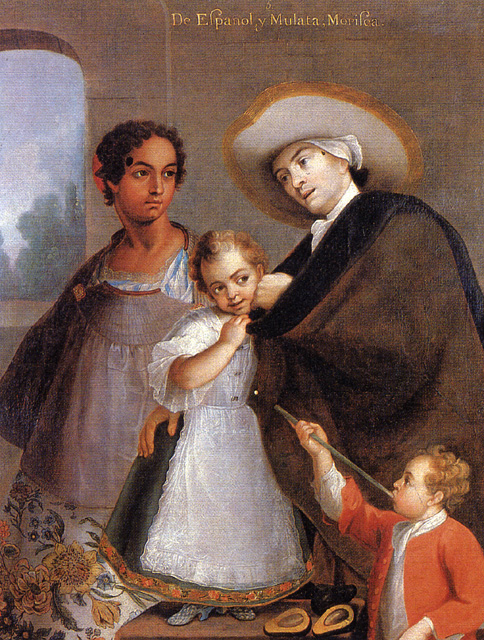Early explorations and conquests were made by theSpanish and the Portuguese immediately following their own final reconquest of Iberia in 1492. In the 1494 Treaty of Tordesillas, ratified by the Pope, these two kingdoms divided the entire non-European world into two areas of exploration and colonization, with a north to south boundary that cut through the Atlantic Ocean and the eastern part of present-day Brazil. Based on this treaty and on early claims by Spanish explorer Vasco Núñez de Balboa, discoverer of the Pacific Ocean in 1513, the Spanish conquered large territories in North, Central and South America.
Spanish conquistador Hernán Cortés took over theAztec Kingdom and Francisco Pizarro conquered the Inca Empire. As a result, by the mid-16th century, the Spanish Crown had gained control of much of western South America, Central Americaand southern North America, in addition to its earlierCaribbean territories. Over this same timeframe,Portugal colonized much of eastern South America, naming it Brazil.
Other European nations soon disputed the terms of the Treaty of Tordesillas. England and Franceattempted to plant colonies in the Americas in the 16th century, but these failed. England and France succeeded in establishing permanent colonies in the following century, along with the Dutch Republic. Some of these were on Caribbean islands, which had often already been conquered by the Spanish or depopulated by disease, while others were in eastern North America, which had not been colonized by Spain north of Florida.
Early European possessions in North America included Spanish Florida, Spanish New Mexico, the English colonies of Virginia (with its North Atlantic off-shoot, Bermuda) and New England, the French colonies of Acadiaand Canada, the Swedish colony of New Sweden, and the Dutch New Netherland. In the 18th century,Denmark–Norway revived its former colonies in Greenland, while the Russian Empire gained a foothold inAlaska.
As more nations gained an interest in the colonization of the Americas, competition for territory became increasingly fierce. Colonists often faced the threat of attacks from neighboring colonies, as well as from indigenous tribes and pirates.
Early state-sponsored colonists
Portugal in the Age of Discovery, Spanish colonization of the Americas, and First European colonization wave (15th century–19th century)
The first phase of well-financed European activity in the Americas began with the Atlantic Ocean crossings of Christopher Columbus (1492–1504), sponsored by Spain, whose original attempt was to find a new route to India and China, known as "the Indies". He was followed by other explorers such as John Cabot, who was sponsored by England and reached Newfoundland. Pedro Álvares Cabral reached Brazil and claimed it for Portugal.
Amerigo Vespucci, working for Portugal in voyages from 1497 to 1513, established that Columbus had reached a new set of continents. Cartographers still use a Latinized version of his first name, America, for the two continents. Other explorers included Giovanni da Verrazzano, sponsored by France; the Portuguese João Vaz Corte-Real in Newfoundland; and Samuel de Champlain (1567–1635) who explored Canada.
In 1513, Vasco Núñez de Balboa crossed the Isthmus of Panama and led the first European expedition to see the Pacific Ocean from the west coast of the New World. In an action with enduring historical import, Balboa claimed the Pacific Ocean and all the lands adjoining it for the Spanish Crown. It was 1517 before another expedition, from Cuba, visited Central America, landing on the coast of Yucatán in search of slaves.
These explorations were followed, notably in the case of Spain, by a phase of conquest: The Spaniards, having just finished the Reconquista of Spain from Muslim rule, were the first to colonize the Americas, applying the same model of governing to the former Al-Andalus as to their territories of the New World.
Ten years after Columbus's discovery, the administration of Hispaniola was given to Nicolás de Ovando of the Order of Alcántara, founded during the Reconquista. As in the Iberian Peninsula, the inhabitants of Hispaniola were given new landmasters, while religious orders handled the local administration. Progressively the encomienda system, which granted tribute (access to indigenous labor and taxation) to European settlers, was set in place.
A relatively common misconception is that a small number of conquistadores conquered vast territories, aided only by disease epidemics and their powerful caballeros. In fact, recent archaeological excavations have suggested a vast Spanish-Indian alliance numbering in the hundreds of thousands. Hernán Cortés eventuallyconquered Mexico and the Tlaxcala in 1519-1521, while the conquest of the Inca was carried out by some 40,000 Incan renegades led by Francisco Pizarro in between 1532 and 1535.
Over the first century and a half after Columbus's voyages, the native population of the Americas plummeted by an estimated 80% (from around 50 million in 1492 to eight million in 1650), mostly by outbreaks of Old Worlddiseases.
In 1532, Charles V, Holy Roman Emperor sent a vice-king to Mexico, Antonio de Mendoza, in order to prevent Cortes' independentist drives, who definitively returned to Spain in 1540. Two years later, Charles V signed theNew Laws (which replaced the Laws of Burgos of 1512) prohibiting slavery and the repartimientos, but also claiming as his own all the American lands and all of the autochthonous people as his own subjects.
When in May 1493, the Pope Alexander VI issued the Inter caetera bull granting the new lands to the Kingdom of Spain, he requested in exchange an evangelization of the people. Thus, during Columbus's second voyage, Benedictine friars accompanied him, along with twelve other priests. As slaverywas prohibited between Christians, and could only be imposed in non-Christian prisoners of war or on men already sold as slaves, the debate on Christianization was particularly acute during the 16th century. In 1537, the papal bull Sublimis Deus recognized that Native Americans possessed souls, thus prohibiting their enslavement, without putting an end to the debate. Some claimed that a native who had rebelled and then been captured could be enslaved nonetheless. Later, the Valladolid controversy opposed the Dominican priest Bartolomé de Las Casas to another Dominican philosopher Juan Ginés de Sepúlveda, the first one arguing that Native Americans were beings doted with souls, as all other human beings, while the latter argued to the contrary and justified their enslavement. The process of Christianization was at first violent: when the first Franciscansarrived in Mexico in 1524, they burned the places dedicated to pagan cult, alienating much of the local population.
In the 1530s, they began to adapt Christian practices to local customs, including the building of new churches on the sites of ancient places of worship, leading to a mix of Old World Christianity with local religions. The Spanish Roman Catholic Church, needing the natives' labor and cooperation, evangelized in Quechua, Nahuatl,Guaraní and other Native American languages, contributing to the expansion of these indigenous languages and equipping some of them with writing systems. One of the first primitive schools for Native Americans was founded by Fray Pedro de Gante in 1523.
To reward their troops, the Conquistadores often allotted Indian towns to their troops and officers. Black African slaves were introduced to substitute for Native American labor in some locations—including the West Indies, where the indigenous population was nearing extinction on many islands.
During this time, the Portuguese gradually switched from an initial plan of establishing trading posts to extensivecolonization of what is now Brazil. They imported millions of slaves to run their plantations. The Portuguese and Spanish royal governments expected to rule these settlements and collect at least 20% of all treasure found (theQuinto Real collected by the Casa de Contratación), in addition to collecting all the taxes they could. By the late 16th century American silver accounted for one-fifth of Spain's total budget. In the 16th century perhaps 240,000 Europeans entered American ports.

